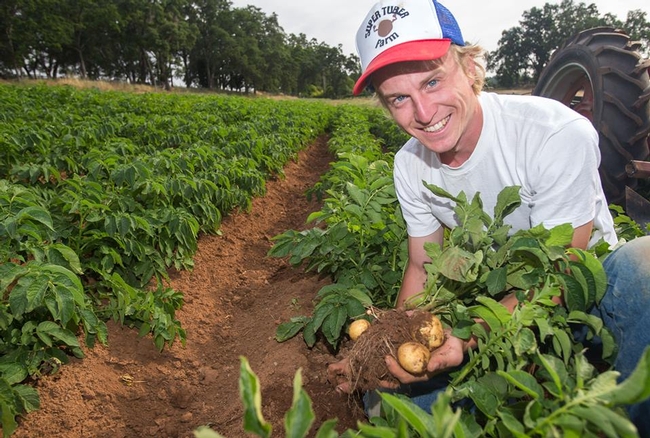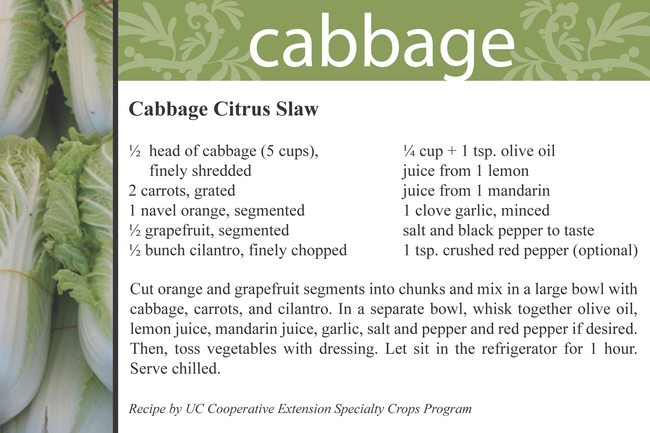- Author: Deena Miller
Though it feels like the Farmers Markets of Nevada County have long since finished, a short drive down the hill into Placer County there is a year round market with bushels of beautiful winter vegetables. The Auburn market in the Old Town Courthouse Parking Lot is open every Saturday, 8 AM until noon.
Jim of Jim's Produce from Wheatland is still attending the market rocking his signature bowtie and offering a dozen different vegetables, from storage crops like sweet potatoes to crunchy winter lettuce. Jim and other farmers have the sweetest carrots of the year due to a phenomenon called “cold-sweetening” which causes the plant to store sugars in a more readily available form, and therefore less susceptible to freezing. If you are craving food fresh from the fields, it is definitely worth the trip to Auburn.
Other crops that were sighted last Saturday: an abundance of citrus of all kinds including Satsuma, Pixie, and Murcott mandarins, Washington and other navel oranges, Moro blood oranges, Meyer and Lisbon lemons, Oro Blanco and Rio Red grapefruit, Miewa kumquats, Minneola tangelos, and the exotic mandarinquat! There are other winter fruits available as well: apples (Pink Lady, Granny Smith, Fuji) and kiwi. A huge selection of vegetables are coming out of our local farm fields: Brussels sprouts, cabbage, lettuce, leeks, beets, daikon, sweet potatoes, winter squash, kale, collards, parsley, radicchio, watermelon radishes, radishes, turnips, rutabagas, broccoli, tatsoi, bok choi, potatoes, gai lan (Chinese sprouting broccoli), arugula, cilantro, cauliflower, kohlrabi, and more. You can also pick-up dried fruit, sprouts, and olive oil this time of year.
Never had kohlrabi or a kumquat? Since you are buying directly from the growers, they can often give you a few ideas about how to enjoy this unknown produce. Kohlrabi was the most asked about vegetable at the Sweet Roots Farm market stand. Shaped like a spaceship, and sometimes a vibrant purple, it is botanically the same species as broccoli, but selected for its enlarged stem instead of flowers - broccoli florets. Peel the tough outer skin, then eat it raw with dips, grate it like a carrot in slaws, substitute it for jicama. You can also use it like a broccoli stem in stir-fries or soups, or roast kohlrabi sticks with garlic and parmesan cheese. Don't forget to use the greens, you can use them the same as you would use kale.
Check out this easy Citrus Cabbage Slaw recipe, and don't be shy about adding kohlrabi. You could also substitute Brussels sprouts since they are essentially mini cabbages, just be careful when shredding!
Eating locally in the winter can take a little more effort and cooperation, particularly if you don't have a farmers' market in your neighborhood. Share a ride to the market or offer to pick up produce for your neighbors. Also, make sure to purchase both fresh and storage crops, and your trip to the winter farmers' market will feed you great produce for weeks. Adventuring out to a year-round farmers' market will be well worth your time- the flavors of winter are delicious!
- Author: Deena Miller
What is something you are enjoying eating from your farm right now?
We are just starting to harvest some carrots that have been the ground for a while and I'm really enjoying their sweet flavor. We direct seeded them in the end of August and they are just now the appropriate size.
Are you growing or raising anything new in 2015?
I'm going to be trying a few new things such as seeds crops and maybe early tomatoes in a hoop house. I think the thing I'm most excited about is getting better at working with the baby salad greens in 2015, better production methods and having a more abundant supply throughout the fall and into the winter.
What crops or tools are you leaving behind in 2014?
Sadly we will be discontinuing our much loved sweet corn.
What is your favorite tool?
My favorite tool is our barrel washer. It cuts down on potato washing time 20 to 30 fold. It is something we built based on commercial potato washers, and we use it all the time.
~Watch the barrel washer in action: https://www.facebook.com/supertuberfarm/videos

- Author: Dan Macon
Storage crops like potatoes, onions, beets, and winter squash are always part of our winter vegetable rotation, but what do you do when you need that crunch we so love from fresh produce? I turn to the daikon! A much beloved staple in many Asian cultures, one large daikon radish usually lasts about a week in a typical Japanese household with each section of the white root used for different dishes. From pickled daikon called takuan to braised rounds, this mild radish can be pickled, dried, cooked, fermented to make kimchi or consumed in the simplest fashion, raw.
I am a vegetable and flower farmer in a particularly cold part of Nevada County. Unless we cover our winter vegetables under tunnels, the frosts and birds make our greens not very appealing. Even with handfuls of the especially sweet winter spinach there just isn't the variety of summer vegetables to choose from, so it takes a little more effort to eat our vegetables.
Simply slice daikon like a cucumber in a sandwich, add it to a slaw with carrots and cabbage, grate it finely to add to dipping sauces, or do a quick pickle in vinegar and mirin.
We add daikon to many meals as a simple and delicious condiment by grating a large bowl and sprinkling rice wine vinegar over it. Every bite of a stir-fry, roasted vegetables or meat, or falafel can be enhanced with the addition of a little daikon.
You will be surprised at how this one vegetable can bring so much variety to winter cooking flavors!
Where to find Daikon: Look for this great white root on Saturdays at the Auburn Farmers Market in the courthouse parking lot. You can also purchase it year round from most grocery stores. Pick out roots that are firm with bright green tops, they should not give when squeezed, then store in a plastic bag without the tops for up to two weeks. The most enjoyable way to get daikon is to grow your own! Kids love to pull the monster roots from the ground, and by dedicating just a few square feet of a deeply tilled garden bed to direct seed Raphanus sativus in early September, you can enjoy it through the winter.
~Deena Miller, Sweet Roots Farm

- Author: Molly Nakahara
Have you ever wondered why there are no tangerines available at our local farmers' markets? As Horticulture and Small Farms Advisor, Cindy Fake, explains in her article "A Mandarin By Any Other Name," the word 'tangerine' is a marketing term used to describe certain types of mandarins!
To find out more about the history and culture of our delicious, local mandarins, read her full article here:
A Mandarin By Any Other Name, by Cindy Fake

- Author: Dan Macon

Despite these many benefits, economic viability continues to be challenging for many small farms and ranches. As I think about these challenges, I'm beginning to realize that biology plays a role in farm viability and scale of operation. After all, a farmer can only grow such much kale on an acre of farmland! And farm income is directly related to crop yield - even with high value crops.
For a more technical discussion of these issues, I encourage you to check out the latest post in our Farming in the Foothills blog!



